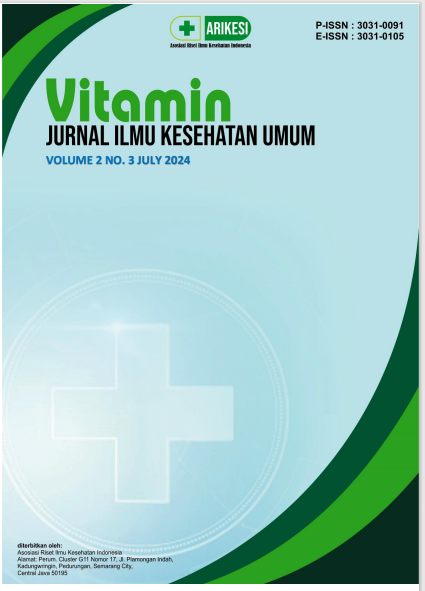Penerapan Pijat Akupresur pada Ibu Hamil Trimester I untuk Mengatasi Masalah Emesis Gravidarum di Wilayah Kerja Puskesmas Putri Ayu Kota Jambi
DOI:
https://doi.org/10.61132/vitamin.v2i4.775Keywords:
Acupressure Massage, Emesis Gravidarum, Pregnant WomenAbstract
Nausea and vomiting or emesis gravidarum are the most common discomforts in the first trimester of pregnancy. If nausea and vomiting are not treated immediately, the body will become weak, dehydrated and have a pale face. Based on the results of the study, Mrs. D, 32 years old, first trimester of pregnancy with the main complaint of nausea and vomiting. One way to reduce nausea and vomiting is with acupressure massage techniques. Acupressure massage is done by gently pressing the PC 6 point for 2 minutes, the aim of which is to have an effect on giving acupressure massage to pregnant women in the first trimester to overcome the problem of emesis gravidarum. The method used is a case study with data collection techniques through observation, interviews and physical examination with the superior intervention of acupressure massage to reduce emesis gravidarum or nausea and vomiting. The results showed that there was a diagnosis of nausea with the intervention of giving acupressure massage for 3 days. The results showed that after the acupressure massage there was a decrease in the Pregnancy Unique Quantification of Emesis and/or Nausea (PUQE) score on the first day of the intervention with a score of 8 (moderate nausea and vomiting category) after the day all three interventions with a score of 3 (mild nausea and vomiting category). Conclusion: Application of acupressure massage can reduce emesis gravidarum or nausea and vomiting in first trimester pregnant women.
Downloads
References
Abdillah, W., & Hartono, J. (2015). Partial least square (PLS) – Alternative structural equation modelling (SEM) dalam penelitian bisnis. CV Andi Offset.
Antoni, M. (2012). Tanda bahaya dalam kehamilan. In Buku pintar kehamilan (pp. xx–xx). EGC.
Balai Kesehatan Tradisional Masyarakat (BKTM). (2013). Efektivitas akupresur terhadap keluhan mual muntah pada ibu hamil trimester pertama di Kota Makassar tahun 2013. Makassar.
Dinarti, & Muryanti, Y. (2017). Bahan ajar keperawatan: Dokumentasi keperawatan.
Gahayu, P., & Dwienda, O. R. (2021). Penerapan teknik akupresur untuk mengurangi keluhan mual muntah pada kehamilan trimester 1. Jurnal Kebidanan Terkini, 1(2), 70–78.
Hutahaean, S. (2013). Perawatan antenatal. Salemba Medika.
Indriyani, D. (2013). Aplikasi konsep dan teori keperawatan maternitas hiperemesis gravidarum. Ar-Ruzz Media.
Iriyanti, Bayu, Dkk. (2014). Asuhan kehamilan berbasis bukti. Sagung Seto.
Janiwarty, B. (2013). Pendidikan psikologi untuk bidan: Suatu teori dan terapannya. Rapha Publishing.
Maharani, et al. (2019). Asuhan kebidanan kehamilan. Media Sains Indonesia.
Mochtar, R. (2012). Sinopsis obstetric. EGC.
Murdiyanti, D., Nuril, & Rahmita. (2019). Buku terapi komplementer: Konsep dan aplikasi dalam keperawatan. PT Pustaka Baru.
National Centre for Biotechnology Information (NCBI). (2020). Data ibu hamil dengan emesis gravidarum.
Nowo, S. R. (2023). Pengaruh tindakan akupresur terhadap mual muntah di titik pericardium 6 pada ibu hamil trimester 1 di Penawar Jaya Kec. Banjar Margo Kab. Tulang Bawang. Jurnal Ilmu Kesehatan, 2(2), 1–8.
PPNI, T. pokja S. D. (2017). Standar diagnosis keperawatan Indonesia: Definisi dan indikator diagnostik. Dewan Pengurus PPNI.
Reeder, M., & Griffin, K. (2011). Keperawatan maternitas kesehatan wanita, bayi, & keluarga. EGC.
Renityas, N. (2020). Pengaruh titik nei guan (P6) terhadap pengurangan keluhan morning sickness pada ibu hamil trimester I di Puskesmas Sanawetan Blitar. Juke, 3(1).
Sharma, N. (2021). Nausea and vomiting in pregnancy. International Journal of Research and Review, 4(4), 48–51.
Somoyani, N. K. (2020). Literature review: Terapi komplementer untuk mengurangi mual muntah pada masa kehamilan. Jurnal Ilmiah Kebidanan, 8(1), 10–17.
Sutejo. (2023). Keperawatan jiwa (Tarmizi, Ed.; cetakan ke-). Bumi Medika.
Tanjung, W. W., Wari, Y., & Antoni, A. (2020). Pengaruh akupresur pada titik perikardium 6 terhadap intensitas mual muntah pada ibu hamil trimester I. Jurnal Education and Development, 8(4), 265–265.
Wulandari, I., Sulisetyawati, S. D., & Purnomo. (2024). Penerapan terapi spiritual wudhu terhadap tanda dan gejala pada pasien risiko perilaku kekerasan di ruang Geranium RSJD dr. RM Soedjarwadi Klaten. Jurnal Keperawatan, 10, 1–7.
Downloads
Published
How to Cite
Issue
Section
License
Copyright (c) 2024 Vitamin : Jurnal ilmu Kesehatan Umum

This work is licensed under a Creative Commons Attribution-ShareAlike 4.0 International License.





